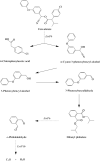Whole genome sequencing and analysis of fenvalerate degrading bacteria Citrobacter freundii CD-9
- PMID: 35523901
- PMCID: PMC9076782
- DOI: 10.1186/s13568-022-01392-z
Whole genome sequencing and analysis of fenvalerate degrading bacteria Citrobacter freundii CD-9
Abstract
Citrobacter freundii CD-9 is a Gram-negative bacteria sourced from factory sludge that can use fenvalerate as its sole carbon source and has a broad degradation spectrum for pyrethroid pesticides. The whole genome of CD-9 sequenced using Illumina HiSeq PE150 was reported in this study. The CD-9 genome size was 5.33 Mb and the G + C content was 51.55%. A total of 5291 coding genes, 9 5s-rRNA, and 79 tRNA were predicted bioinformatically. 3586 genes annotated to the Kyoto Encyclopedia of Genes and Genomes (KEGG) database that can be involved in 173 metabolic pathways, including various microbial metabolic pathways that degrade exogenous chemicals, especially those that degrade aromatic compounds, and also produce a variety of bioactive substances. Fifty genes related to pyrethroid degradation were identified in the C. freundii CD-9 genome, including 9 dioxygenase, 25 hydrolase, and 16 esterase genes. Notably, RT-qPCR results showed that from the predicted 13 genes related to fenvalerate degradation, the expression of six genes, including esterase, HAD family hydrolase, lipolytic enzyme, and gentisic acid dioxygenase, was induced in the presence of fenvalerate. In this study, the key genes and degradation mechanism of C. freundii CD-9 were analyzed and the results provide scientific evidence to support its application in environmental bioremediation. It can establish application models for different environmental pollution management by constructing genetically engineered bacteria for efficient fenvalerate or developing enzyme formulations that can be industrially produced.
Keywords: Bioremediation; Genomics; Pyrethroids; RT-qPCR.
© 2022. The Author(s).
Conflict of interest statement
All authors declare that they have no competing interests.
Figures








Similar articles
-
Biodegradation and metabolic pathway of fenvalerate by Citrobacter freundii CD-9.AMB Express. 2020 Oct 30;10(1):194. doi: 10.1186/s13568-020-01128-x. AMB Express. 2020. PMID: 33125615 Free PMC article.
-
Isolation of Dibutyl Phthalate-Degrading Bacteria and Its Coculture with Citrobacter freundii CD-9 to Degrade Fenvalerate.J Microbiol Biotechnol. 2022 Feb 28;32(2):176-186. doi: 10.4014/jmb.2110.10048. J Microbiol Biotechnol. 2022. PMID: 35058397 Free PMC article.
-
Comparative Genome Analysis of the Lignocellulose Degrading Bacteria Citrobacter freundii so4 and Sphingobacterium multivorum w15.Front Microbiol. 2020 Mar 3;11:248. doi: 10.3389/fmicb.2020.00248. eCollection 2020. Front Microbiol. 2020. PMID: 32194522 Free PMC article.
-
New insights into the microbial degradation and catalytic mechanism of synthetic pyrethroids.Environ Res. 2020 Mar;182:109138. doi: 10.1016/j.envres.2020.109138. Epub 2020 Jan 14. Environ Res. 2020. PMID: 32069744 Review.
-
Insight Into Microbial Applications for the Biodegradation of Pyrethroid Insecticides.Front Microbiol. 2019 Aug 2;10:1778. doi: 10.3389/fmicb.2019.01778. eCollection 2019. Front Microbiol. 2019. PMID: 31428072 Free PMC article. Review.
Cited by
-
Distinct gut bacterial composition in Anoplophora glabripennis reared on two host plants.Front Microbiol. 2023 Jun 19;14:1199994. doi: 10.3389/fmicb.2023.1199994. eCollection 2023. Front Microbiol. 2023. PMID: 37405158 Free PMC article.
-
Unveiling six novel bacterial strains for fipronil and thiobencarb biodegradation: efficacy, metabolic pathways, and bioaugmentation potential in paddy soil.Front Microbiol. 2024 Oct 22;15:1462912. doi: 10.3389/fmicb.2024.1462912. eCollection 2024. Front Microbiol. 2024. PMID: 39502414 Free PMC article.
References
-
- Arbeli Z, Fuentes CL. Accelerated biodegradation of pesticides: an overview of the phenomenon, its basis and possible solutions; and a discussion on the tropical dimension. Crop Prot. 2007;26(12):1733–1746. doi: 10.1016/j.cropro.2007.03.009. - DOI
-
- Aregbesola OA, Kumar A, Mokoena MP, Olaniran AO. Whole-genome sequencing, genome mining, metabolic reconstruction and evolution of pentachlorophenol and other xenobiotic degradation pathways in Bacillus tropicus strain AOA-CPS1. Funct Integr Genomics. 2021;21(2):171–193. doi: 10.1007/s10142-021-00768-x. - DOI - PubMed
-
- Ashburner M, Ball AC, Blake JA, Botstein D, Butler H, Cherry JM, Davis AP, Dolinski K, Dwight SS, Eppig JT, Harris MA, Hill DP, Issel-Tarver L, Kasarskis A, Lewis S, Matese JC, Richardson JE, Ringwald M, Rubin GM, Sherlock G. Gene ontology: tool for the unification of biology. Nat Genet. 2000;25(1):25–29. doi: 10.1038/75556. - DOI - PMC - PubMed
Grants and funding
- 32102094/National Nature Science Foundation of China
- 2019YJ0389/Application Foundation Project of Sichuan Provincial Department of Science and Technology
- No. 2019ZYZF0170/Science and Technology Support Project of Sichuan Province
- 2018-YF05-00522-SN/Technological Innovation Project of Chengdu Science and Technology Bureau
- Z1310525/Key Scientific Research Fund of Xihua University
LinkOut - more resources
Full Text Sources
Miscellaneous

